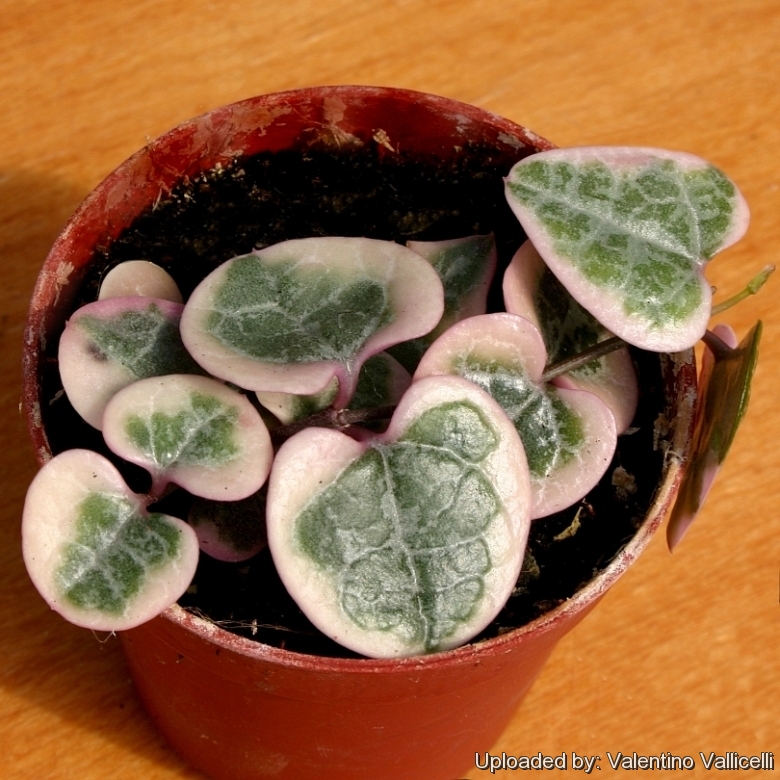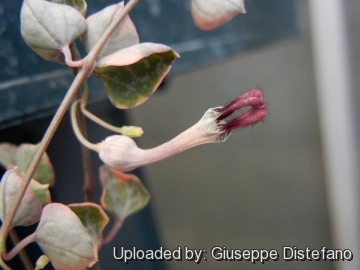
Ceropegia linearis subs. woodii f. variegata Photo by: Valentino Vallicelli
Beautiful cream and pink variegated leaves
Origin and Habitat: Garden origin (Nursery produced cultivar). The wild species occurs over a considerable range from Southern Africa (Eastern Cape Province) trough Swaziland, and Zimbabwe.
Synonyms:
See all synonyms of Ceropegia linearis
Common Names include:
ENGLISH: Rosary Vine, Collar of Hearts, Heart Strings, Chain of Hearts, Keepsake Heart, Sweetheart vine, Hearts-on-a-string, Chinese Lantern, String of hearts
CHINESE (中文): 愛之蔓, 爱之蔓锦
HEBREW (עברית): שעוונית זוחלת
SPANISH (Español): Collar de corazones
Description: Succulent, evergreen trailing vine, that grows to 2-5 cm in height and spreads to reach up to 2-4 m in length.
Stem: Thin and pendulous from which leaves hang,
Leaves: Heart shaped that look somewhat like cyclamen leaves and marbled with shades of silver and green on the top, and green to purple on the undersurface. They are opposite
Tubers: The roots, and occasionally the stems, will often develop tubers. On the stems these form at nodes and are likely the reason for the common name of rosary vine. The tubers are that forms at regular intervals on the stems can be used to propagate the plant
Flowers: In general shape similar to those of other Ceropegia species, waxy, narrow. and bulbous at the base. (resemble small upturned vases) 2,5-3 cm long, off-white and pale magenta. The five petals are a deeper purple/ brown.
Blooming season: The Ceropegia woodii blooms in profusion most in late summer-autumn (but flowers continues to appear till mid-winter if growing-conditions are adequate).
Fruits: Horn-shaped seed pods containing flat seeds with their own little parachute, that are carried by any draft. They can be sowed immediately
Subspecies, varieties, forms and cultivars of plants belonging to the Ceropegia linearis group
 Ceropegia linearis subs. woodii f. variegata Photo by: Giuseppe Distefano
Ceropegia linearis subs. woodii f. variegata Photo by: Giuseppe Distefano Ceropegia linearis subs. woodii f. variegata Photo by: Giuseppe Distefano
Ceropegia linearis subs. woodii f. variegata Photo by: Giuseppe DistefanoCultivation and Propagation: Ceropegia linearisSN|22143]]SN|22143]] subs. woodii forms the most striking trailing stems if grown in a suspended basket. In a warm Mediterranean climate, it can be grown as a ground cover as well. During the growing period it requires heat, light and adequate watering. However the flowers are most interesting and worth the trouble, only bearing in mind that this species benefits from slightly warmer winter than others.
Growth rate: The plants grow profusely and can fill a 25 cm pot in just a year or two given the best conditions. The all green variety tends to grow more quickly (although it's still slow by most houseplant standards) and is arguably more hardy, but it also comes in a some pretty slow growing variegated varieties.
Soil: This plant does well in a rich cactus potting mix, but can become too elongated if compost is too rich. Use pot with good drainage.
Transplantation: Repotting every 2-3 years. The trick is to be as careful as possible, as it falls apart easily. Add some potting mix (compost) to the new container to bring the repotted plant to the correct height. Cautiously upturn the old container, supporting the plant with a gentle hand, position the root ball into the new container, add extra potting mix to fill any empty spaces, and carefully arrange the pearls to hang over the pot.
Watering: Water regularly during the growing season every weeks or so, making sure to drench and letting all the water drain out of the pot. If all the leaves fall off don't fret, stop watering and wait until it starts to grow again. Less water during winter months. In the rest period no high atmospheric humidity!! Care must be taken with watering as they tends to become swollen and untidy in growth habit if given too much water and shade.
Fertilization: Use a liquid plant food that is for cacti and succulents rich in potassium and phosphorous, but poor in nitrogen, because this chemical element doesn’t help the development of succulent plants, making them too soft and full of water.
Exposure: Grow ii slight dappled shade including two to three hours a day of direct sunlight through the year, which encourages flowering and heavy leaf production.
Hardiness: Reputedly sensitive to frost, but less so if kept on the dry side prior to, and during, cold weather (hardy to -5° C for short periods). However some warmth throughout the year will increase the grower's success (minimum 5° to 8°C during rest season). It does not like hot weather and needs cool air with ample airflow. In the rest period no high atmospheric humidity!!
Pest & diseases: Just be sure to treat for aphids and mealy bugs if they appear. Rot it is only a minor problem with succulents if the plants are watered and “aired” correctly. If they are not, fungicides won't help all that much.
Growing practices: The stem grows over a meter long and racks or other long cane-like structures are needed to climb up.
Propagation: Stem cuttings are easy to propagate, cut off strings near a node and stick them into fresh soil to restart. The cuttings should root in 2 to 6 weeks. It will form potato-like lumps under the soil.













